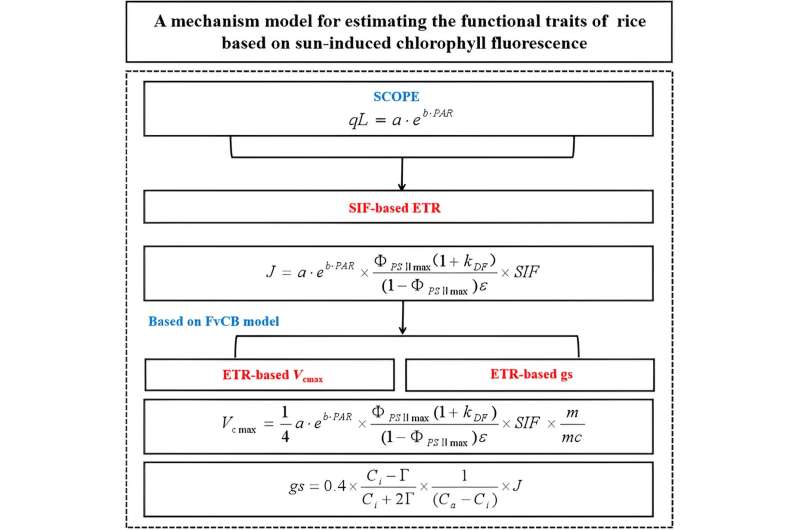This article has been reviewed according to Science X's editorial process and policies. Editors have highlighted the following attributes while ensuring the content's credibility:
fact-checked
proofread
Crop yield prediction: New model uses sun-induced chlorophyll fluorescence for enhanced photosynthetic trait estimation

Crops use carbon dioxide (CO2) through photosynthesis to create organic matter, with enhanced photosynthetic rates crucial for meeting global food demands. While crop phenomics has focused on structural traits, it's the functional traits like maximum carboxylation rate (Vcmax) and stomatal conductance (gs) that are vital for accurate predictions of crop yield.
Sun-induced chlorophyll fluorescence (SIF) has emerged as a novel method to estimate these traits. Recent studies highlight a nonlinear relationship between SIF and electron transport rate, suggesting a potential approach to assessing crop photosynthetic efficiency, crucial for improving crop productivity and understanding environmental responses.
In May 2023, Plant Phenomics published a research article titled "A Mechanistic Model for Estimating Rice Photosynthetic Capacity and Stomatal Conductance from Sun-Induced Chlorophyll Fluorescence." In this study, a semi-mechanistic model was developed to estimate the seasonal variations in Vcmax and gs of crops by utilizing SIF.
The model was validated against field observations, revealing its high accuracy in estimating Vcmax and gs (R2 > 0.8). This outperformed simple linear regression models by more than 40 % in terms of accuracy. This advancement enhances the estimation of crop's functional traits, providing new perspectives into high-throughput monitoring techniques and a more profound understanding of crop's physiological responses to climate change.
Key results include the establishment of a coupling relationship between the open ratio of photosystem II (qL) and photosynthetically active radiation (PAR), revealing a nonlinear reduction in qL with increasing PAR. This relationship was subsequently employed to compute the electron transport rate (ETR) throughout the rice growing seasons, revealing a robust correlation between canopy SIF and ETR.
The model effectively tracked seasonal dynamics of Vcmax, correlating well with field observations and showing distinct trends across different years, underscoring its sensitivity to environmental factors like temperature.
Similarly, the model accurately estimated gs from SIF observations, with the seasonal trajectories of estimated gs aligning closely with field observations. While the model exhibited slight overestimation under certain conditions, its overall performance was robust, demonstrating its potential for widespread application in estimating rice functional traits.
The study concludes by underscoring the model's implications in accurately assessing global crop photosynthesis and predicting crop yield. It also indicates the potential to extend the model from site-level to global scales by using satellite SIF observations, thereby enhancing our comprehension of crop responses to climate change.
However, the study acknowledges the necessity for improved SIF observation quality and further exploration of SIF–ETR relationships under varied environmental conditions, indicating potential avenues for future research.
More information: Hao Ding et al, A Mechanistic Model for Estimating Rice Photosynthetic Capacity and Stomatal Conductance from Sun-Induced Chlorophyll Fluorescence, Plant Phenomics (2023). DOI: 10.34133/plantphenomics.0047
Provided by TranSpread



















